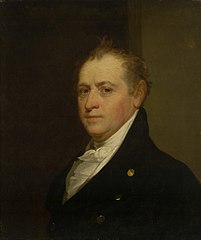| Oliver Wolcott Jr. | |
|---|---|
 | |
| Born |
Oliver Wolcott Jr. January 11, 1760 Litchfield, Connecticut Colony, British America |
| Died |
June 1, 1833 (aged 73) New York City, New York |
| Education |
Yale University read law |
| Predecessor | John Cotton Smith |
| Successor | Gideon Tomlinson |
| Relatives | Roger Wolcott |
| Signature |
 |
Oliver Wolcott Jr. (January 11, 1760 – June 1, 1833) was the 2nd United States Secretary of the Treasury, a United States Circuit Judge of the United States Circuit Court for the Second Circuit and the 24th Governor of Connecticut.
Education and career[]

Bureau of Engraving and Printing portrait of Wolcott as Secretary of the Treasury
Born on January 11, 1760, in Litchfield, Connecticut Colony, British America,[1] Wolcott served in the Continental Army from 1777 to 1779, during the American Revolutionary War, then graduated from Yale University in 1778 and read law in 1781.[1] He was clerk of the Connecticut Committee on Pay-Table from 1781 to 1782.[1] He was a member of the Connecticut Committee on Pay-Table from 1782 to 1784.[1] He was a commissioner to settle claims of Connecticut against the United States from 1784 to 1788.[1] He was Comptroller of Public Accounts for Connecticut from 1788 to 1789.[1] He was Auditor for the United States Department of the Treasury from 1789 to 1791.[1] He was Comptroller for the United States Department of the Treasury from 1791 to 1795.[1] He was a commission merchant in New York City, New York from 1793 to 1815.[1] He was the 2nd United States Secretary of the Treasury from 1795 to 1800.[1]
Martha Washington's escaped slave[]
In late May 21, 1796, one of Martha Washington's slaves, Oney Judge, escaped from the Executive Mansion in Philadelphia, where she lived with the Washingtons during his presidency, serving as Martha's chambermaid.[2] As Secretary, Wolcott was George Washington's intermediary in getting the Collector of Customs for Portsmouth, New Hampshire, Joseph Whipple, to capture and send Martha Washington's runaway slave, Oney Judge (sometimes Ona), to Mount Vernon, where she had begun serving the Washingtons.[3] Whipple met with Oney, discussed why she had escaped and tried to ascertain the facts of the case. After she told him she did not desire to be a slave again, Whipple refused to remove Judge against her will, saying that it could cause civil unrest due to abolitionists, and recommended the President go through the courts if needed.[4] In their correspondence, Washington said that he wanted to avoid controversy, so he did not use the courts to take advantage of the method he himself had signed into law under the 1793 Slave Act.[5]
Washington made another attempt to apprehend her in 1798. This time he asked his nephew, Burwell Bassett Jr. to convince her to return or to take her by force,[6] but Oney was warned by senator John Langdon and hid.[7] Wolcott's involvement with this case ended with the first attempt to return Oney Judge to slavery.[8]
Federal judicial service[]
Wolcott was nominated by President John Adams on February 18, 1801, to the United States Circuit Court for the Second Circuit, to a new seat authorized by 2 United States Statutes at Large 89.[1][9] He was confirmed by the United States Senate on February 20, 1801, and received his commission the same day.[1] His service terminated on July 1, 1802, due to abolition of the court.[1]
Later career[]
Wolcott was a farmer from 1815 to 1816.[1] He was the 24th Governor of Connecticut from 1817 to 1827.[1] He was a candidate for Governor of Connecticut in 1827.[1] He was the 5th Grand Master of the Most Worshipful Grand Lodge of the State of Connecticut of Ancient, Free & Accepted Masons from 1818 to 1820.[10]
Death[]
Wolcott died on June 1, 1833, in New York City.[1]
Honor[]
The town of Wolcott, Connecticut was named in honor of Oliver Jr. and his father Oliver Sr.[citation needed] About 1798, Fort Washington on Goat Island in Newport, Rhode Island was renamed Fort Wolcott.[citation needed] Fort Wolcott was an active fortification until 1836.[citation needed] It later became the site of the United States Naval Torpedo Station, which became the location of the United States Naval War College.[citation needed]
References[]
- ↑ 1.00 1.01 1.02 1.03 1.04 1.05 1.06 1.07 1.08 1.09 1.10 1.11 1.12 1.13 1.14 1.15 1.16
- Oliver Wolcott at the Biographical Directory of Federal Judges, a public domain publication of the Federal Judicial Center.
- ↑ Runaway advertisement, The Pennsylvania Gazette (Philadelphia), May 24, 1796.
- ↑ "Search John C. Fitzpatrick's The Writings of George Washington". Etext.virginia.edu. http://etext.virginia.edu/etcbin/ot2www-washington?specfile=/texts/english/washington/fitzpatrick/search/gw.o2w&act=surround&offset=44096522&tag=Writings+of+Washington,+Vol.+35:+*To+THE+SECRETARY+OF+THE+TREASURY&query=girl+i+mentioned+to+you&id=gw350157. Retrieved 2011-01-23.
- ↑ George Washington and slavery: a documentary portrayal. Google Books. 1997. ISBN 9780826211354. https://books.google.com/?id=4YX3czE0SGYC&pg=PA114&lpg=PA114&dq=%22Library+of+congress%22+%22whipple+to+wolcott%22#v=onepage&q=%22Library%20of%20congress%22%20%22whipple%20to%20wolcott%22&f=false. Retrieved 2011-01-23.
- ↑ "Search John C. Fitzpatrick's The Writings of George Washington". Etext.lib.virginia.edu. http://etext.lib.virginia.edu/etcbin/ot2www-washington?specfile=/texts/english/washington/fitzpatrick/search/gw.o2w&act=surround&offset=44325369&tag=Writings+of+Washington,+Vol.+35:+*To+JOSEPH+WHIPPLE+&query=point+of+sailing&id=gw350210. Retrieved 2011-01-23.
- ↑ "Ona, Runaway Slave of George Washington". Seacoast NH Black History. http://seacoastnh.com/blackhistory/ona.html. Retrieved 2011-01-23.
- ↑ Lawler, Edward (1995-07-04). "Oney Judge". Ushistory.org. http://www.ushistory.org/presidentshouse/slaves/oney.htm. Retrieved 2011-01-23.
- ↑ For additional information see Edward Lawler Jr.
- ↑ Ferling, John (2004). Adams vs. Jefferson: the tumultuous election of 1800. New York: Oxford University Press. p. 199. ISBN 0-19-516771-6. https://archive.org/details/adamsvsjefferson00ferl/page/199.
- ↑ Case, James Royal (1989). A Bicentennial History Of The Grand Lodge Of Connecticut (1st ed.). Wallingford, CT: Grand Lodge of Connecticut. p. 321.
Sources[]
- Oliver Wolcott at the Biographical Directory of Federal Judges, a public domain publication of the Federal Judicial Center.
External links[]
- Oliver Wolcott Jr. House
- The Ingraham Library
- Oliver Wolcott, Jr. at Find a Grave
The original article can be found at Oliver Wolcott, Jr. and the edit history here.